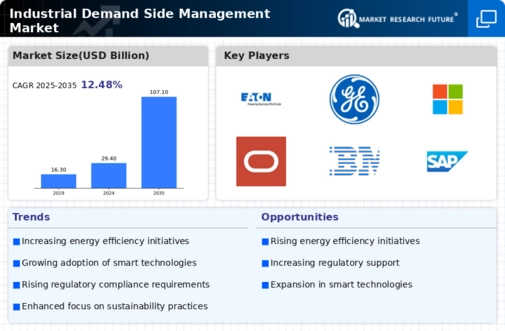Rising Energy Costs
The Industrial Demand Side Management Market is also driven by the rising costs of energy, which compel industries to seek more efficient energy management solutions. As energy prices continue to escalate, companies are increasingly motivated to implement demand-side management strategies to mitigate costs. Reports suggest that energy expenditures can account for up to 30% of total operational costs in manufacturing sectors. Consequently, industries are investing in technologies that allow for better energy monitoring and control, thereby reducing waste and enhancing efficiency. This trend indicates a growing recognition of the importance of energy management, positioning the Industrial Demand Side Management Market for substantial growth as companies prioritize cost-effective energy solutions.
Regulatory Frameworks
The Industrial Demand Side Management Market is significantly influenced by evolving regulatory frameworks aimed at promoting energy efficiency. Governments are increasingly implementing policies that encourage industries to adopt demand-side management strategies. For instance, regulations that mandate energy audits and efficiency improvements are becoming commonplace. These policies often come with incentives such as tax breaks or grants for companies that invest in energy-saving technologies. Data indicates that regions with stringent energy regulations have seen a 20% increase in the adoption of demand-side management practices. This regulatory push not only fosters a competitive environment but also propels the growth of the Industrial Demand Side Management Market as companies strive to comply with these standards.
Technological Advancements
The Industrial Demand Side Management Market is experiencing a surge in technological advancements that enhance energy efficiency and operational effectiveness. Innovations such as smart meters, advanced analytics, and automation systems are being integrated into industrial processes. These technologies enable real-time monitoring and control of energy consumption, allowing industries to optimize their energy use. According to recent data, the implementation of smart grid technologies is projected to increase energy efficiency by up to 30% in various sectors. This trend not only reduces operational costs but also aligns with the growing demand for sustainable practices. As industries adopt these technologies, the Industrial Demand Side Management Market is likely to expand, driven by the need for improved energy management solutions.
Increased Focus on Sustainability
The Industrial Demand Side Management Market is witnessing a heightened focus on sustainability, driven by both consumer demand and corporate responsibility. Industries are increasingly recognizing the importance of sustainable practices, not only to meet regulatory requirements but also to enhance their brand image. This shift is leading to the adoption of energy-efficient technologies and practices that reduce carbon footprints. Data shows that companies implementing demand-side management strategies can achieve energy savings of up to 25%, contributing to their sustainability goals. As the emphasis on environmental stewardship grows, the Industrial Demand Side Management Market is likely to benefit from the increasing number of industries committed to sustainable energy practices.
Market Competition and Innovation
The Industrial Demand Side Management Market is characterized by intense competition and innovation among key players. As more companies enter the market, there is a continuous push for innovative solutions that enhance energy efficiency and reduce costs. This competitive landscape encourages the development of new technologies and services tailored to meet the specific needs of various industries. For instance, companies are exploring artificial intelligence and machine learning to optimize energy consumption patterns. The introduction of such innovations is expected to drive market growth, as industries seek to differentiate themselves through superior energy management solutions. Consequently, the Industrial Demand Side Management Market is poised for expansion as competition fosters a culture of innovation.


















Leave a Comment